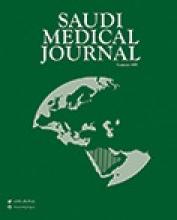Abstract
OBJECTIVE: A pharmacoepidemiological study of prescription pattern in outpatient clinics in Southwestern Saudi Arabia
METHODS: A total of 3796 prescriptions from outpatient clinics of Aseer Central Hospital, Abha, Kingdom of Saudi Arabia were screened randomly and systemically over one-year period (April 2000 to April 2001). The prescriptions were analyzed for the essential elements of the prescription order, and for the number and classes of drugs prescribed, source of prescription and appropriateness of prescription to the diagnosis.
RESULTS: The source of prescriptions was not provided in 61.5% of prescriptions. The diagnosis was missing in 15.1% and not readable in 18.9% of prescriptions. Upper respiratory tract infection (URTI) was the most frequent diagnosis and was included in 21.6% of prescriptions. The average number of drugs per prescription was 2.1 +/- 1.05 (Mean +/- SD), with 90.8% of prescriptions containing 3 or fewer drugs. The most frequently prescribed drugs were nonsteroidal anti-inflammatory drugs (NSAIDs), including paracetamol which were included in 51.2% of prescriptions, followed by antibacterial agents (33.2%). Only 46.4% of prescriptions were appropriate to the diagnosis, while 11.1% were partially appropriate and 5.3% were inappropriate. For the rest (37.2%), it was difficult to evaluate appropriateness due to deficient information. General practitioners and specialists were more likely to prescribe appropriately than emergency room physicians (64.6% and 60.4% versus 35.7%). None of the prescriptions for antiplatelet and anticoagulant drugs and antihypertensive agents were inappropriate.
CONCLUSION: These results emphasize the need for continuing medical education on rational prescribing, and for periodic monitoring of physicians habits on drug utilization.
- Copyright: © Saudi Medical Journal
This is an open-access article distributed under the terms of the Creative Commons Attribution-Noncommercial-Share Alike 3.0 Unported, which permits unrestricted use, distribution, and reproduction in any medium, provided the original work is properly cited.






